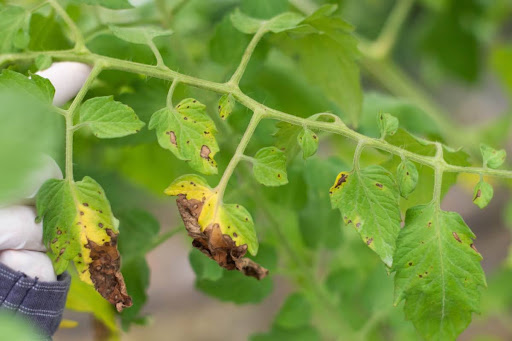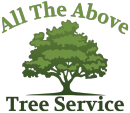How to Identify Tree Diseases & Pests
December 15, 2024

Trees are a cornerstone of any vibrant landscape, offering beauty, shade, and environmental benefits. But like all living things, they’re vulnerable to diseases and pests that can threaten their health and even lead to their decline. The good news? Early detection and swift action can save infected trees from lasting damage and stop problems before they spiral out of control.
As part of our mission to educate property owners about preserving their outdoor spaces, our All the Above Tree Service team is here to go over how to identify tree diseases and pests. This way, you’ll know what to keep an eye out for and can reach out to our crew of arborists for help. We offer a range of solutions from emergency tree removal to stump grinding and everything in between. If you suspect disease or insects may be infiltrating your trees, do not hesitate to give us a call.
Common Tree Diseases in Bucks County, PA
Tree diseases come in many forms, often caused by fungi, bacteria, or viruses, each targeting different tree species and parts of the tree. Some of the most prevalent diseases include hardwood leaf diseases like powdery mildew and rust fungi, which frequently affect young and mature hardwood trees during humid seasons.
Bacterial diseases such as fire blight are especially harmful to fruit trees, causing widespread damage to branches and bark. Another infamous disease is Dutch elm disease, a fungal infection that has decimated elm trees by attacking their vascular systems. Fungal diseases target tree roots and structural stability, making them particularly concerning. Pine root diseases, for instance, often affect pine species, leading to internal decay and the growth of visible fungal conks at the tree’s base. These diseases can weaken the tree’s foundation and increase the risk of collapse.
With such a wide variety of diseases impacting different plant species, recognizing the specific type of infection affecting your tree is key to providing effective treatment.
Signs of Tree Disease
Early detection is the key to saving infected trees and preventing the spread of harmful pathogens. Tree diseases often manifest through subtle yet distinctive symptoms that can easily go unnoticed by untrained eyes. By learning to recognize these warning signs, you can take proactive steps to save your landscape from the perils of tree diseases.
Key indicators of potential infection include:
- Discolored or Wilted Leaves: This includes hardwood leaf diseases such as brown, yellow, or spotted leaves that appear out of season.
- Cracks or Oozing Sap on the Tree’s Bark: The bark may become brittle, peel away, or show dark, weeping spots.
- Growth of Fungi or Mold: Rust fungi, powdery mildew, or mushrooms at the base of tree trunks often signal infection.
- Dead or Infected Branches: Branch dieback can result from diseases like fire blight or Dutch elm disease.
- Visible Cankers or Wounds: Swollen, sunken, or discolored areas on the trunk or branches can indicate disease.
- Poor Growth or Small Leaves: Stunted growth is a sign that the tree roots may be compromised by pine root diseases or similar issues.
Tree Disease Treatments
Treatment options vary based on the specific disease and severity of the infection. For minor infections like powdery mildew, pruning infected branches and applying fungicides may be enough. Diseases impacting tree roots or bark, however, often require more intensive interventions, such as soil treatments or injections into the tree’s vascular system.
Professional arborists can identify the plant species and tailor treatments to the specific needs of your tree species. Proactive care like mulching, fertilizing, and proper irrigation can also improve resistance to future infections, promoting healthy trees across your property.
Typical Tree Pests in Bucks County, PA
Tree pests like bark beetles, aphids, and emerald ash borers are common in Bucks County. Emerald ash borers are particularly destructive to ash trees, boring into their trunks and disrupting the tree’s ability to transport nutrients, which can quickly lead to tree death. These pests, along with others like caterpillars that strip away leaves, also target fruit trees, pine species, and hardwood trees. Seasonal patterns, especially in early summer, often coincide with increased pest activity. Without timely intervention, these pests can cause extensive damage, weaken tree structures, and lead to widespread infestations.
Indications of Infestation
Pest infestations can be just as destructive as diseases, often working silently to compromise tree health. Recognizing the early signs of pest activity can mean the difference between saving a tree and facing complete tree removal. Understanding these indicators requires careful observation and knowledge of local pest behaviors.
Clear signs of pest infestation include:
- Holes in Tree Trunks or Branches: Often caused by bark beetles, borers, or similar pests.
- Frass or Sawdust-Like Material: Found around the base of the tree or within holes in the bark.
- Sticky Sap or Honeydew: Produced by aphids and scale insects, it can attract mold or fungi.
- Chewed or Skeletonized Leaves: Indicates feeding by caterpillars or other leaf-eating pests.
- Unusual Bark Patterns: Girdling or peeling bark is a sign of a severe infestation.
Solutions for Tree Pests
Effective pest management is a multifaceted approach that combines scientific understanding with strategic intervention. Professional arborists employ integrated pest management techniques that minimize environmental impact while effectively controlling pest populations. These methods might include biological controls, targeted chemical treatments, and long-term prevention strategies. Each solution is customized based on the specific pest, tree species, and environmental conditions, ensuring the most effective and sustainable approach to pest control.
When Disease or Pests Might Cause the Need for Tree Removal
In severe cases, diseases or infestations can compromise a tree’s structural integrity, posing a risk to people or property. When tree roots are heavily damaged or the tree’s bark is extensively stripped, the likelihood of recovery diminishes. Diseased or infested trees can also spread problems to nearby trees. Signs like hollow trunks, dead branches, or advanced rot often warrant removal. While we aim to preserve trees whenever possible, removal is sometimes the best choice for safety and preventing further issues.
Suspect Tree Disease or Pest? Call Us for an Evaluation
If you think your trees might be infected or infested, don’t wait for the problem to get worse. At All the Above Tree Service, our certified arborists specialize in identifying and treating tree diseases and pests to keep your trees healthy and thriving. Contact us today for a comprehensive evaluation and expert care to protect your property and its natural beauty.
